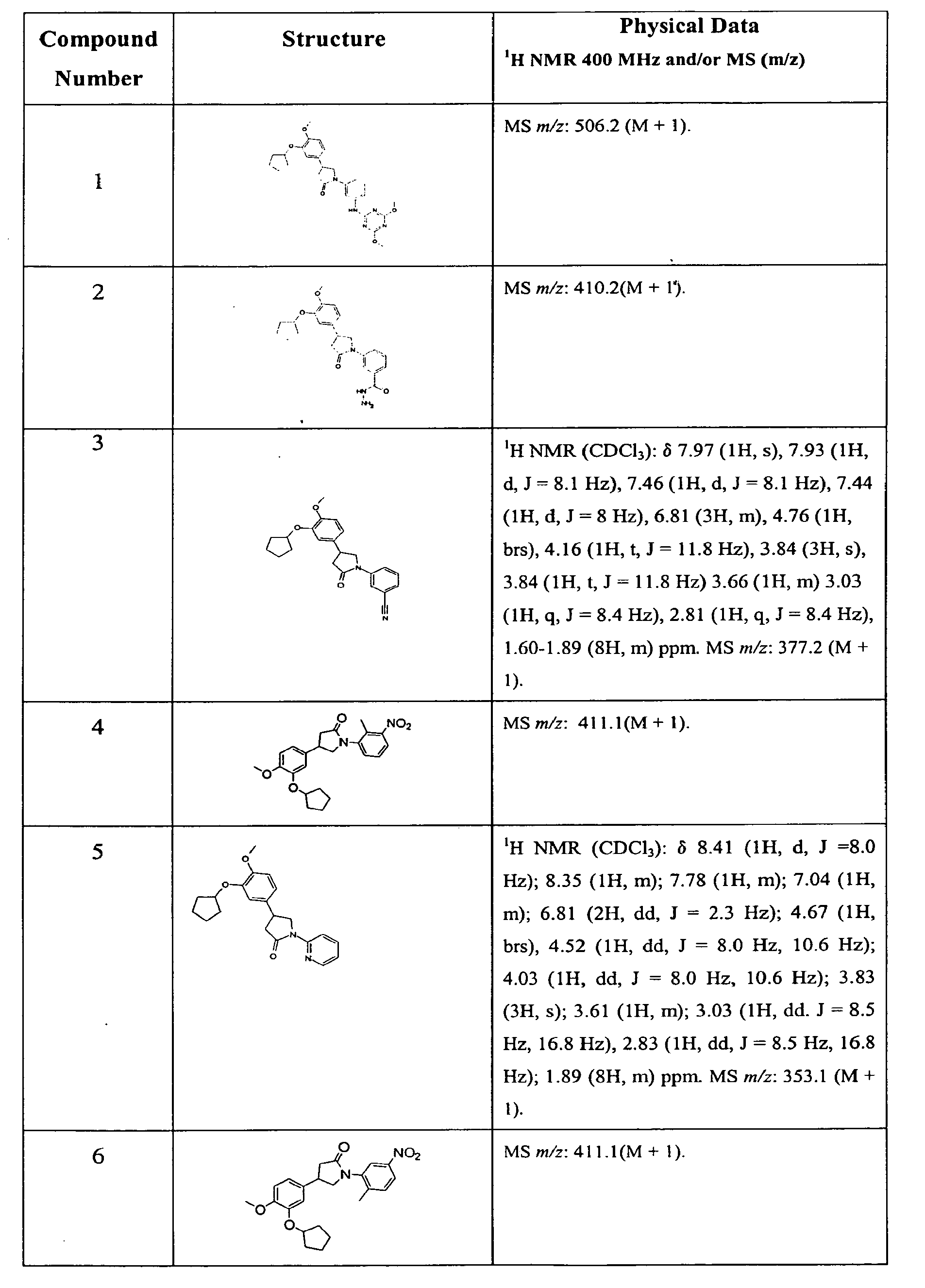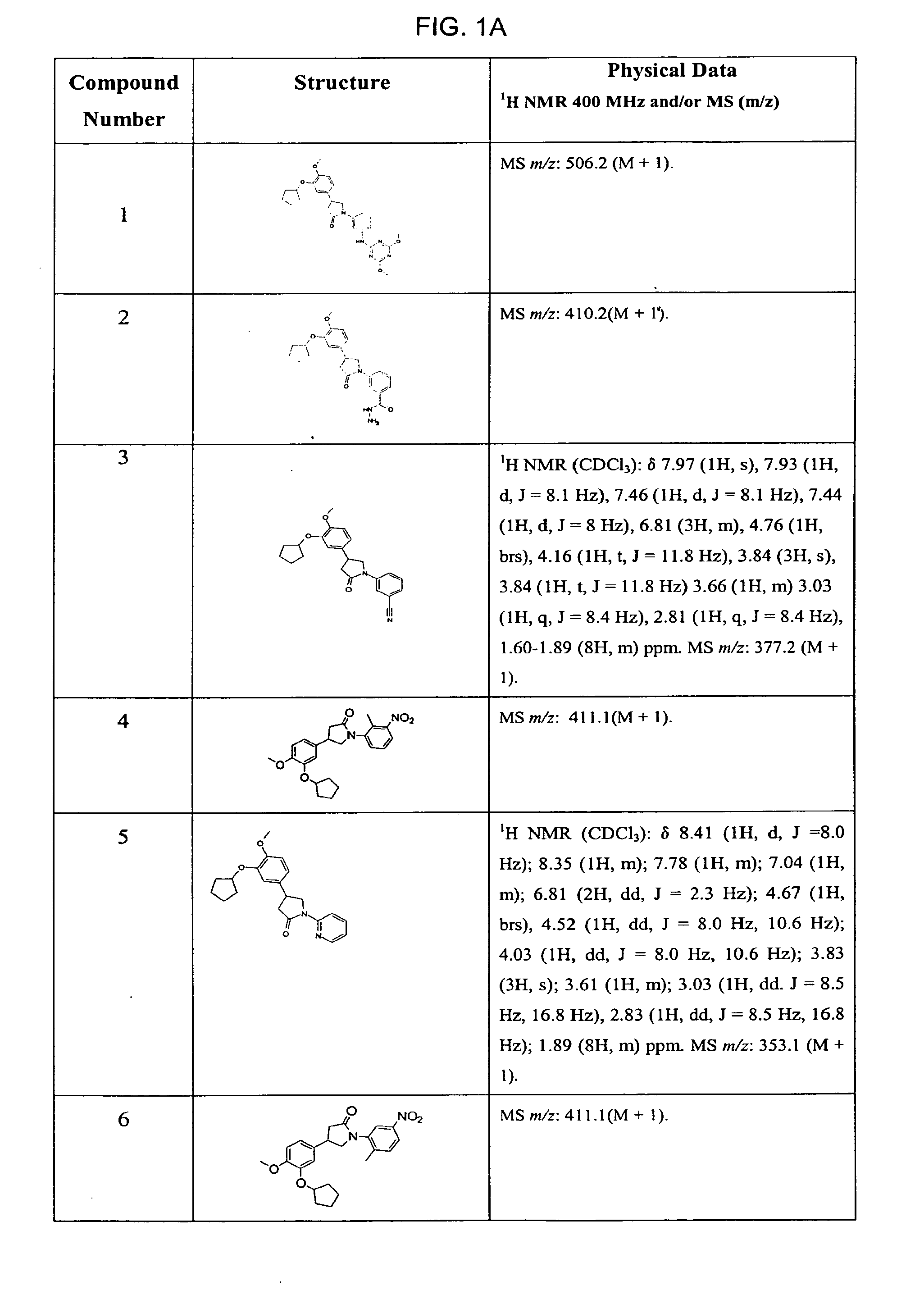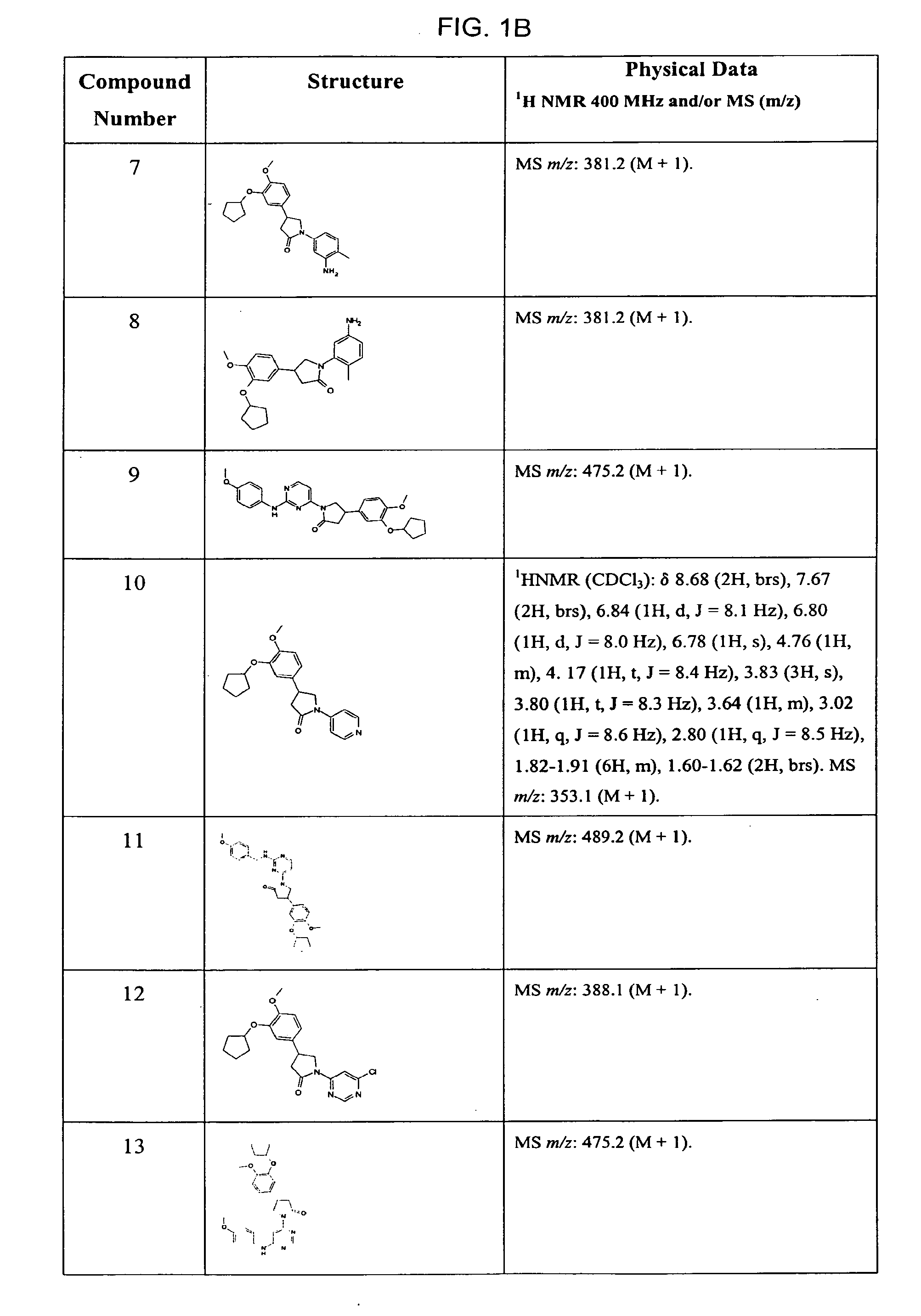Pyrrolidones with Anti-hiv activity
a technology of pyrrolidone and anti-hiv, which is applied in the field of inhibition of viruses, can solve the problems of reducing the effectiveness of the immune system, changing the glycoprotein surface of the viral protective coat, and eradicating the virus from the body. it can effectively inhibit the replication of hiv
- Summary
- Abstract
- Description
- Claims
- Application Information
AI Technical Summary
Benefits of technology
Problems solved by technology
Method used
Image
Examples
example 1
[0174]
1.1 Preparation of 3-[4-(3-cyclopentyloxy-4-methoxyphenyl)-2-oxo-pyrrolidin-1-yl]-benzonitrile, according to General Procedure II
[0175]A mixture of 4-(3-cyclopentyloxy-4-methoxyphenyl)-pyrrolidin-2-one (1.5 g, 5 mmol), 3-bromobenzonitrile (1.36 g, 7.5 mmol), potassium phosphate (1.9 g, 9.8 mmol), and 1,2-trans-cyclohexanediamine (60 μL) was created in a dry round bottom flask under nitrogen containing DMF (9 mL) and dioxane (9 mL). The mixture was stirred and CuI (100 mg) was added. The resulting reaction mixture was heated to 110° C. with stirring under N2 for 20 h, and then cooled to r.t. The mixture was diluted with EtOAc and then filtered. The filtrate was washed with saturated aqueous solutions of NH4Cl and brine, dried over MgSO4, and concentrated under reduced pressure.
[0176]Chromatography on silica gel (EtOAc:hexane=1:3 to 1:1) gave 1.81 g of 3-[4-(3-cyclopentyloxy-4-methoxy-phenyl)-2-oxo-pyrrolidin-1-yl]benzonitrile. Yield: 90%.
1.1a 3-[4-(3-cyclopentyloxy-4-methoxyphe...
example 2
[0180]
2.1 Preparation of N-{3-[4-(3-cyclopentyloxy-4-methoxyphenyl)-2-oxo-pyrrolidin-1-yl]-phenyl}-3-methoxybenzenesulfonamide according to General Procedure VII
[0181]A mixture of 1-(3-aminophenyl)-4-(3-cyclopentyloxy-4-methoxyphenyl)-pyrrolidin-2-one (15 mg, 0.04 mmol) and 3-methoxybenzenesulfonyl chloride (10 mg, 0.042 mol) in pyridine (30 μL) and CH2Cl2 (0.5 mL) was created in a dry round bottom flask. The mixture was stirred at r.t. for 15 h. After removal of solvent, the residue was purified by preparative LC-MS to give 14 mg of N-{3-[4-(3-cyclopentyloxy-4-methoxyphenyl)-2-oxo-pyrrolidin-1-yl]phenyl}-3-methoxybenzenesulfonamide. Yield: 65%.
2.1. a N-{3-[4-(3-cyclopentyloxy-4-methoxyphenyl)-2-oxo-pyrrolidin-1-yl]-phenyl}-3-methoxybenzenesulfonamide
[0182]1H NMR (CDCl3): δ 7.70 (1H, brs), 7.37 (1H, d, J=7.8 Hz), 7.19-7.29 (4H, m), 7.00 (2H, t, J=7.6 Hz); 6.83 (1H, d, J=8 Hz), 6.79 (1H, s), 6.79 (1H, d, J=8 Hz), 4.76 (1H, brs), 4.11 (1H, t, J=8.4 Hz), 3.83 (3H, s), 3.78 (1H, t, J=8....
example 3
[0183]
3.1 Preparation of N-{3-[4-(3-cyclopentyloxy-4-methoxyphenyl)-2-oxo-pyrrolidin-1-yl]-phenyl}-3-dimethylaminobenzamide
[0184]A mixture of carboxylic acid (0.02 mmol), diisopropylethylamine (0.04 mmol) and 1-(3-dimethylaminopropyl)-3-ethylcarbodiimide hydrochloride (EDC) (0.024 mmol, 1.2 eq) in dry THF was stirred for 20 min before the addition of 1-(3-aminophenyl)-4-(3-cyclopentyloxy-4-methoxyphenyl)pyrrolidin-2-one (0.02 mmol). The reaction mixture was then stirred for 30 h. Concentration under reduced pressure and purification by column chromatography on silica gel gave the desired product.
3.1. a N-{3-[4-(3-cyclopentyloxy-4-methoxyphenyl)-2-oxo-pyrrolidin-]-yl-phenyl}-3-dimethylaminobenzamide
[0185]MS m / z 514.2 (M+1).
PUM
| Property | Measurement | Unit |
|---|---|---|
| molecular weight | aaaaa | aaaaa |
| molecular weight | aaaaa | aaaaa |
| molecular weights | aaaaa | aaaaa |
Abstract
Description
Claims
Application Information
 Login to View More
Login to View More - R&D
- Intellectual Property
- Life Sciences
- Materials
- Tech Scout
- Unparalleled Data Quality
- Higher Quality Content
- 60% Fewer Hallucinations
Browse by: Latest US Patents, China's latest patents, Technical Efficacy Thesaurus, Application Domain, Technology Topic, Popular Technical Reports.
© 2025 PatSnap. All rights reserved.Legal|Privacy policy|Modern Slavery Act Transparency Statement|Sitemap|About US| Contact US: help@patsnap.com



